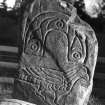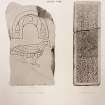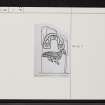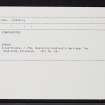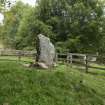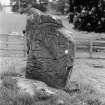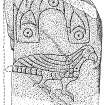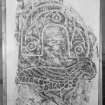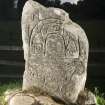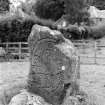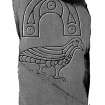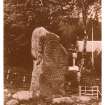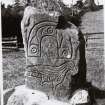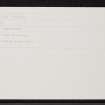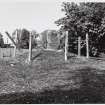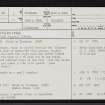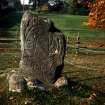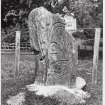Following the launch of trove.scot in February 2025 we are now planning the retiral of some of our webservices. Canmore will be switched off on 24th June 2025. Information about the closure can be found on the HES website: Retiral of HES web services | Historic Environment Scotland
Strathpeffer, Clach An Tiompain
Pictish Symbol Stone (Pictish)
Site Name Strathpeffer, Clach An Tiompain
Classification Pictish Symbol Stone (Pictish)
Alternative Name(s) Strathpeffer, The Eaglestone
Canmore ID 12458
Site Number NH45NE 6
NGR NH 48487 58511
Datum OSGB36 - NGR
Permalink http://canmore.org.uk/site/12458
- Council Highland
- Parish Fodderty
- Former Region Highland
- Former District Ross And Cromarty
- Former County Ross And Cromarty
Strathpeffer, Ross and Cromarty, Pictish symbol stone
Measurements: H 0.81m above ground, W 0.61m, D 0.25m
Stone type: blue gneiss
Place of discovery: NH 4845 5852
Present location: in situ in field.
Evidence for discovery: first recorded in the mid nineteenth century. It stands on the edge of a terrace with a cairn of stones around it, but these may result from field clearance in the past. It was set in a concrete base in the twentieth century.
Present condition: good except for damage at the top right-hand corner, caused probably by its use as a sounding stone.
Description
Two large symbols have been heavily incised on one face of this stone: an ornamented arch symbol above an eagle walking to the right.
Date: seventh century.
References: Stuart 1856, pl 108; ECMS pt 3, 61-2; Fraser 2008, no 129.
Desk-based information compiled by A Ritchie 2017.
NH45NE 6 4849 5852.
(NH 4848 5851) Clach an Tiompain (NAT)
OS 6"map, Ross-shire, 1st ed., (1875)
This symbol stone, which is called locally the 'Clachan Tiumpan' is a slab of contorted blue gneiss, roughly rectangular, but with the right hand top corner broken away, 2 ft 8 ins high by 2 ft wide and 10 ins thick, sculptured with incised lines on one face with the horse- shoe symbol, and under it the bird symbol.
J R Allen 1903
This stone stands on a small tumulus.
Name Book 1875
(Name: NH 484 585) Clach an Tiompain (NAT) Symbol Stone (NR)
OS 25"map, (1967)
Clach an Tiompain, a symbol stone as described.
Surveyed at 1:2500.
Visited by OS (N K B) 30 July 1981
No change.
Visited by RCAHMS (JRS) March 1989.
Class I symbol stone bearing on the south-east face a horseshoe above an eagle.
A.Mack 1997 p.120
Publication Account (1995)
A stout slab, somewhat damaged at the top, which has been re-erected in a concrete base in its original position. It bears two symbols: a 'horseshoe' decorated with a curvilinear pattern and below this a realistic eagle with long wing feathers, hooked beak and strong claws. The stone is often called simply 'The Eagle Stone', but its Gaelic name was 'Clach Tiompan' or sounding stone. It is a good example of a Pictish symbol stone and the symbols are deeply incised and easy to see.
Information from ‘Exploring Scotland’s Heritage: The Highlands’, (1995).





























